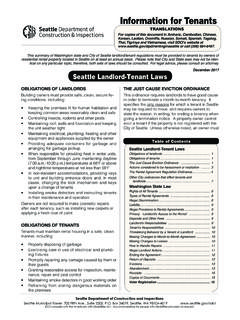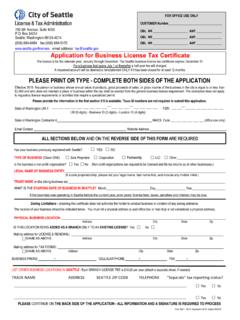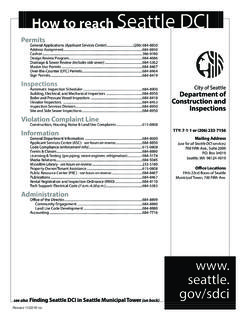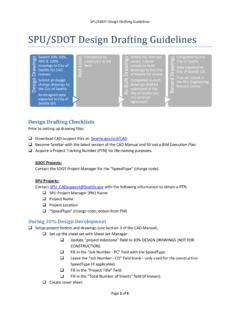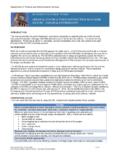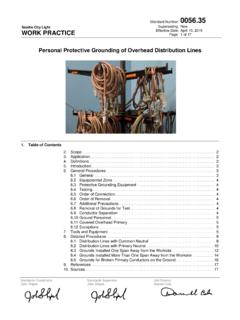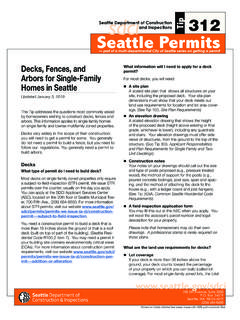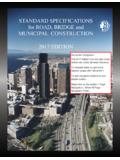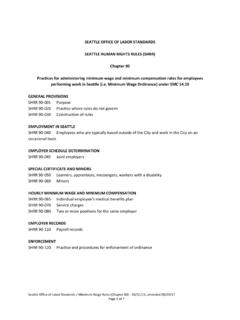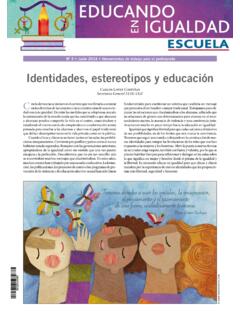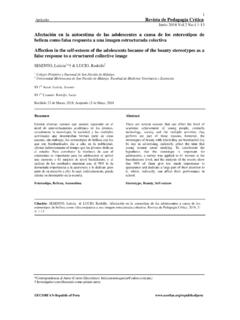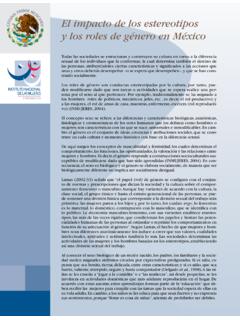Transcription of Racial Equity Toolkit - Seattle
1 Racial Equity Toolkit to Assess Policies, Initiatives, Programs, and Budget Issues The vision of the Seattle Race and Social Justice Initiative is to eliminate Racial inequity in the community. To do this requires ending individual racism, institutional racism and structural racism. The Racial Equity Toolkit lays out a process and a set of questions to guide the development , implementation and evaluation of policies, initiatives, programs, and budget issues to address the impacts on Racial Equity . When Do I Use This Toolkit ? Early. Apply the Toolkit early for alignment with departmental Racial Equity goals and desired outcomes. How Do I Use This Toolkit ? With Inclusion. The analysis should be completed by people with different Racial perspectives. Step by step. The Racial Equity Analysis is made up of six steps from beginning to completion: Step 2. Involve Stakeholders + Analyze Data. Gather information from community and staff on how the issue benefits or burdens the community in terms of Racial Equity .
2 What does data tell you about potential impacts? Step 3. Determine Benefit and/or Burden. Analyze issue for impacts and alignment with Racial Equity outcomes. Step 4. Advance Opportunity or Minimize Harm. Develop strategies to create greater Racial Equity or minimize unintended consequences. Step 1. Set Outcomes. Leadership communicates key community outcomes for Racial Equity to guide analysis. Step 5. Evaluate. Raise Racial Awareness. Be Accountable. Track impacts on communities of color overtime. Continue to communicate with and involve stakeholders. Document unresolved issues. Step 6. Report Back. Share information learned from analysis and unresolved issue with Department Leadership and Change Team. 2 Title of policy, initiative, program, budget issue: _____ Description: _____ Department: _____ Contact: _____ Policy Initiative Program Budget Issue 1a. What does your department define as the most important racially equitable community outcomes related to the issue?
3 (Response should be completed by department leadership in consultation with RSJI Executive Sponsor, Change Team Leads and Change Team. Resources on ) 1b. Which Racial Equity opportunity area(s) will the issue primarily impact? education Community development Health Environment Criminal Justice Jobs Housing 1c. Are there impacts on: Contracting Equity Workforce Equity Immigrant and Refugee Access to Services Inclusive Outreach and Public Engagement Please describe: 2a. Are there impacts on geographic areas? Yes No Check all neighborhoods that apply (see map on ): All Seattle neighborhoods Ballard North NE Central Lake Union Southwest Southeast Delridge Greater Duwamish East District King County (outside Seattle ) Outside King County Please describe: 2b. What are the Racial demographics of those living in the area or impacted by the issue? (See Stakeholder and Data Resources p.)
4 5 and 6) 2c. How have you involved community members and stakeholders? (See for questions to ask community/staff at this point in the process to ensure their concerns and expertise are part of analysis.) Step 1. Set Outcomes. Step 2. Involve stakeholders. Analyze data. Racial Equity Toolkit Assessment Worksheet 3 2d. What does data and your conversations with stakeholders tell you about existing Racial inequities that influence people s lives and should be taken into consideration? (See Data Resources on King County Opportunity Maps are good resource for information based on geography, race, and income.) 2e. What are the root causes or factors creating these Racial inequities? Examples: Bias in process; Lack of access or barriers; Lack of racially inclusive engagement Given what you have learned from data and from stakeholder 3. How will the policy, initiative, program, or budget issue increase or decrease Racial Equity ?
5 What are potential unintended consequences? What benefits may result? Are the impacts aligned with your department s community outcomes that were defined in Step 4. How will you address the impacts (including unintended consequences) on Racial Equity ? What strategies address immediate impacts? What strategies address root causes of inequity listed in How will you partner with stakeholders for long-term positive change? If impacts are not aligned with desired community outcomes, how will you re-align your work? Program Strategies? _____ Policy Strategies? _____ Partnership Strategies? _____ 5a. How will you evaluate and be accountable? How will you evaluate and report impacts on Racial Equity over time? What is your goal and timeline for eliminating Racial inequity? How will you retain stakeholder participation and ensure internal and public accountability? How will you raise awareness about Racial inequity related to this issue?
6 5b. What is unresolved? What resources/partnerships do you still need to make changes? Step 3. Determine Benefit and/or Burden. Step 4. Advance Opportunity or Minimize Harm. Step 5. Evaluate. Raise Racial Awareness. Be Accountable. Step 6. Report Back. Share analysis and report responses from and with Department Leadership and Change Team Leads and members involved in Step 1. 4 Outcome = the result that you seek to achieve through your actions. Racially equitable community outcomes = the specific result you are seeking to achieve that advances Racial Equity in the community. When creating outcomes think about: What are the greatest opportunities for creating change in the next year? What strengths does the department have that it can build on? What challenges, if met, will help move the department closer to Racial Equity goals? Keep in mind that the City is committed to creating Racial Equity in seven key opportunity areas: education , Community development , Health, Criminal Justice, Jobs, Housing, and the Environment.
7 Examples of community outcomes that increase Racial Equity : OUTCOME OPPORTUNITY AREA Increase transit and pedestrian mobility options in communities of color. Community development Decrease Racial disparity in the unemployment rate. Jobs Ensure greater access to technology by communities of color. Community development , education , Jobs Improve access to community center programs for immigrants, refugees and communities of color. Health, Community development Communities of color are represented in the City s outreach activities. education , Community development , Health, Jobs, Housing, Criminal Justice, Environment The Racial diversity of the Seattle community is reflected in the City s workforce across positions. Jobs Access to City contracts for Minority Business Enterprises is increased. Jobs Decrease Racial disparity in high school graduation rates education Additional Resources: RSJI Departmental Work Plan: http://inweb/ Department Performance Expectations: Mayoral Initiatives: Creating Effective Community Outcomes 5 Identify Stakeholders Find out who are the stakeholders most affected by, concerned with, or have experience relating to the policy, program or initiative?
8 Identify Racial demographics of neighborhood or those impacted by issue. (See District Profiles in the Inclusive Outreach and Public Engagement Guide or refer to Census information on ) Once you have indentified your stakeholders .. Involve them in the issue. Describe how historically underrepresented community stakeholders can take a leadership role in this policy, program, initiative or budget issue. Listen to the community. Ask: 1. What do we need to know about this issue? How will the policy, program, initiative or budget issue burden or benefit the community? (concerns, facts, potential impacts) 2. What factors produce or perpetuate Racial inequity related to this issue? 3. What are ways to minimize any negative impacts (harm to communities of color, increased Racial disparities, etc) that may result? What opportunities exist for increasing Racial Equity ? Examples of what this step looks like in practice: A reduction of hours at a community center includes conversations with those who use the community center as well as staff who work there.
9 Before implementing a new penalty fee, people from the demographic most represented in those fined are surveyed to learn the best ways to minimize negative impacts. For resources on how to engage stakeholders in your work see the Inclusive Outreach and Public Engagement Guide: http://inweb1/neighborhoods/outreachguid e/ Tip: Gather Community Input Community meetings Focus groups Consulting with City commissions and advisory boards Consulting with Change Team Identifying Stakeholders + Listening to Communities of Color 6 City of Seattle Seattle s Population and Demographics at a Glance: Website updated by the City Demographer. Includes: Housing Quarterly Permit Report Employment data 2010 Census data 2006-2010 American Community Survey 2010 Census: Demographic highlights from the 2010 Census; Basic Population and Housing Characteristics Change from 1990, 2000, and 2010 PDF report of counts of population by race, ethnicity and over/under 18 years of age as well as a total, occupied and vacant housing unit count; Three-page subject report PDF report of detailed population, household and housing data American Community Survey: 2010 5-year estimates and 2009 5-year estimates Census 2000 Permit Information: Comprehensive Plan Housing Target Growth Report for Urban Centers and Villages; Citywide Residential Permit Report Employment Information: Comprehensive Plan Employment Target Growth Report for Urban Centers and Villages.
10 Citywide Employment 1995-2010 The Greater Seattle Datasheet: a report by the Office of Intergovernmental Relations on many aspects of Seattle and its region. SDOT Census 2010 Demographic Maps (by census blocks): Race, Age (under 18 and over 65) and Median Income http://inweb/ Seattle 's Population & Demographics Related Links & Resources (From DPD website: ) Federal American FactFinder: The Census Bureau's main site for online access to population, housing, economic, and geographic data. Census 2000 Gateway: The Census Bureau's gateway to Census 2000 information. State Washington Office of Financial Management: OFM is the official state agency that provides estimates, forecasts, and reports on the state s population, demographic characteristics, economy, and state revenues. Regional Puget Sound Regional Council: PSRC is the regional growth management and transportation planning agency for the central Puget Sound region in Washington State.
